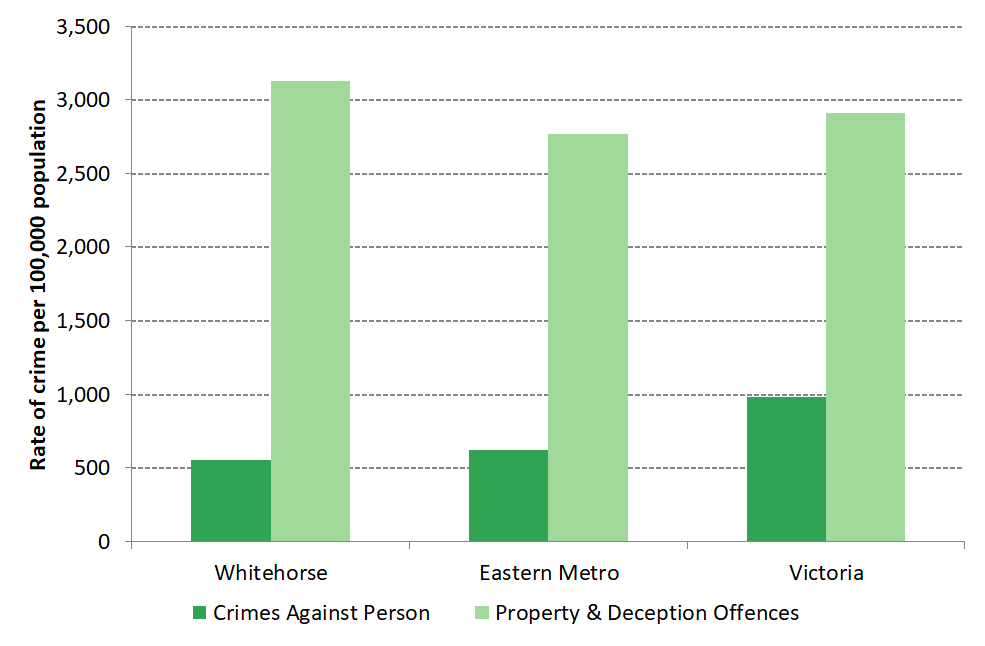This fact sheet provides information about Community Safety in the City of Whitehorse.
Safety
Perceptions of Safety were measured in the 2015 VicHealth Indicators Survey. Respondents were asked to rate how safe they felt when walking alone in their local area during the day and at night.
When walking alone during the day in their local area, 96.3 per cent of persons living in Whitehorse felt safe or very safe, compared to 94.9 per cent in the Inner Metropolitan Region and the Victorian State average of 92.5 per cent. Males in Whitehorse were more likely to feel safe than females (98.8 per cent vs. 93.9 per cent).
When walking alone at night 56.8 per cent of persons in Whitehorse felt safe or very safe, compared to 64.8 per cent in the Inner Metro Region and the Victorian State average of 55.1 per cent. Males in Whitehorse were much more likely to feel safe than females (79.5 per cent vs. 36.1 per cent).
Respondents who stated that they were never alone in the particular situation were not asked to give their perception of how safe they felt and were excluded from the calculation of proportions.

Source: VicHealth Indicators Survey

Source: VicHealth Indicators Survey
Feeling of Trust
How close someone is to their family, friends and people they know can sometimes be connected to longer life expectancy. Being close to others can help you stay healthier in your body and mind. It can also help you when times are tough, like when you're not feeling well or when you are experiencing financial hardship. The Victorian Population Health Survey 2020 asked respondents 'do you agree most people can be trusted?'. In Whitehorse 37.5 per cent agreed that 'yes definitely' most people could be trusted (compared to 35.2 per cent for Victoria), while 14.3 per cent said 'never or not often' (similar to Victoria at 14.2 per cent).
Crime
Crime statistics are produced annually by the Crime Statistics Agency on behalf of Victoria Police. Summaries of offences are reported per 100,000 of the population to enable comparisons across different areas. Offences against the person in Whitehorse are lower than the Eastern Metropolitan and State averages, while offences against property are higher than the Eastern Metropolitan and State averages.
In Whitehorse there were 552 recorded crimes against the person per 100,000 population in 2024, compared to 622 in the Eastern Metropolitan Region and the Victorian State average of 983.
In Whitehorse, there were 3,125 recorded crimes against property per 100,000 population in 2023, compared to 2,768 in the Eastern Metropolitan Region and the Victorian State average of 2,912.

Source: Crime Statistics Agency (2023), Recorded Offences by LGA 2023
Family Violence
Family violence is a significant social, economic and health problem. Family violence is predominantly perpetrated by men against women; however, it affects people throughout the community regardless of gender, age, sexuality, cultural background and socioeconomic class. Violence against women contributes 5.1 per cent towards the burden of disease in Australian women aged 18-44 years.
| Family violence incident rate per 100,000 population (July – June) | ||||||
| LGA | 2018-19 | 2019-20 | 2020-21 | 2021-22 | 2022-23 | % change 2021/22 – 2022/23 |
| Boroondara | 475 | 535 | 583 | 602 | 606 | 0.7% |
| Knox | 1,054 | 1,172 | 1,214 | 1,216 | 1,224 | 0.6% |
| Manningham | 565 | 598 | 727 | 750 | 785 | 4.6% |
| Maroondah | 980 | 1,106 | 1,212 | 1,198 | 1,151 | -3.9% |
| Monash | 704 | 721 | 938 | 1,002 | 932 | -7.0% |
| Whitehorse | 677 | 737 | 854 | 800 | 839 | 4.9% |
| Yarra Ranges | 1,011 | 1,129 | 1,097 | 1,248 | 1,249 | 0.1% |
| Victoria | 1,266 | 1,335 | 1,427 | 1,368 | 1,378 | 0.8% |
Source: Crime Statistics Agency (2024), Family Violence Data Portal
On average 28 incidents of family violence in Whitehorse were reported to police every week throughout 2022/23. The rate of family violence incidents in Victoria per 100,000 of the population was 1.6 times that of Whitehorse in 2022/23, at 1,378 and 839 respectively.
Links
This factsheet provides information about Community Safety in the City of Whitehorse. For more information refer to:



